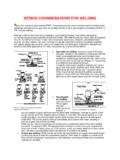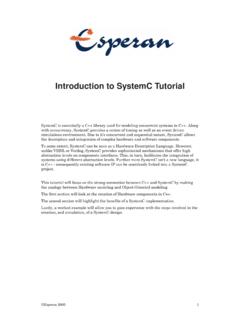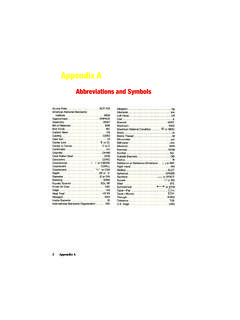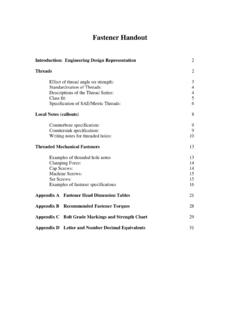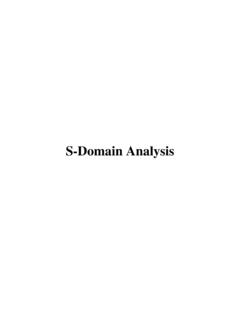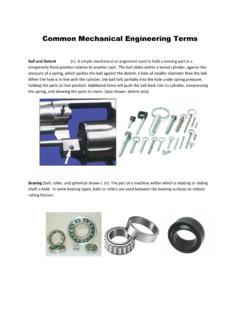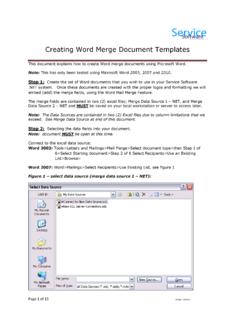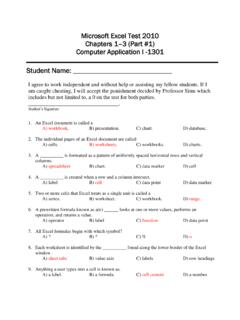Transcription of Product Design Specifications - University of Wisconsin ...
1 Product Design Specifications The Product Design specification (PDS) is a document created during the problem definition activity very early in the Design process. It details the requirements that must be met in order for the Product or process to be successful. The document lays the groundwork for all engineering Design activities and ensures that all relevant factors are accounted for and all stakeholders are heard from. A typical PDS includes the following information: A. Product Design & performance Expected Product size and weight customer requirement Expected Product performance requirements -- the voice of the customer!
2 Operational requirements. Speed (How fast? How slow? How often?) Continuous or discontinuous Loadings likely encountered Product power requirements. Product shelf life. Product service life. Expected Product service environment. What is the operating temperature range for this Product ? What is the operating humidity range for this Product ? Subject to shock loading? Will the Product be exposed to dirt or other contaminants (corrosive fluids, etc.)? Will there be any anomalies in power/fuel available for this Product ? How will the Product be treated in service? What impact will the Product have on its environment?
3 Expected Product safety requirements. Potential sources of Product liability litigation. Potential operator hazards. Potential manufacturing and assembly hazards. Potential for misuse/abuse. Expected Product reliability standards and requirements. What level of reliability can we expect for this Product ? Expected Product ergonomic requirements -- customer requirement Which user/operator features are desirable in this Product ? Are there problem areas for users/operators? Can we Design around them? Expected Product aesthetics -- customer requirement Expected Product maintenance requirements.
4 Can Product be maintenance-free? If routine maintenance is required, can it be done by the owner/operator? Will professional maintenance be required? Possible off-the-shelf component parts. Which parts of this Product be purchased instead of being made by us? Is the quality and reliability of purchases parts adequate for this Design ? Material What are the strength requirements? What are the rigidity/compliance requirements? Is Product weight of importance? Expected Product recycling potential and expected disposal Does the disposal of this Product constitute an environmental hazard?
5 Can parts of this Product be effectively recycled by existing processes? Manufacturing process requirements and limitations. Is protection from the environment necessary? Is there a customer preference for a particular finish? How do we minimize environmental impact? Product packaging requirements. Can we use environmentally friendly packaging and packing materials? How much packaging and packing materials are really necessary? Applicable codes and standards to be checked. Patents to be checked. Processes to research/benchmark. (special processes needed for fabrication?)
6 Product part and prototype testing requirements. B. Market Potential customer base Who will buy this Product ? Why? Have you listed all potential classes of customers? Can we tap into a new segment of the market? How? Market constraints on Product . Who is buying this type Product ? (customer base) What is currently selling? What is currently not selling? Expected Product competition (These will be benchmarked) What are the strengths of each competing Product ? Can we incorporate them? What are the weaknesses of each competing Product ? Can we improve? What are the market shares of competing products?
7 Target Product price -- OEM and MSRP Target production volume and market share. Is there a market for this Product ? How do you know? Is the potential market sufficiently large to justify investment in a new Product ? Is the new Product sufficiently better than the competition? Expected Product distribution environment. How will the packaged Product be treated in shipping, storage, and on the shelf? Are adequate shipping facilities available? Will installation require a professional? C. Capability Company constraints on Product Design , manufacture, and distribution.
8 What are our manufacturing capabilities? Should we manufacture ourselves or outsource? Schedule requirements -- time to market. When should we have this Product to market to capture maximum market share? How much time should we allocate to Design ? How much time do we need to implement a manufacturing process? Writing a PDS Start writing your PDS early in the Design process, typically as soon as you have established engineering requirements and done sufficient research. The PDS is a living document , that is, it will get larger as more about the Design is known.
9 That being said, you should not change existing Specifications unless a major Design change is encountered. Remember, the PDS represents what you are trying to achieve, you should NEVER change it to what has already been achieved. Write a PDF is list format, not as an essay. Quantify your parameters. Use target goals. So not Light Weight but rather weight to be less than 3 kilograms . If you are unsure of a specific parameter, estimate a value and adjust your PDF at a later date. Example (source: Stuart Pugh, Total Design , Addison Wesley, 1991) Surveyor s Pole Stand.
10 A surveyor s pole is used in land surveying for level and distance measurement. It is held vertically at a distance from a measuring device (a theodolite), which is operated by a surveyor. To allow the surveyor to operate independently, a self-supporting surveyor s pole is necessary. The Product Design specification (PDS) for the self-supporting pole is as follows: Performance: To be fixable in position within one minute. Its lower end to contact the ground, even when on irregular terrain. For use on soft or hard ground. The pole to be adjustable for angle so that it stands vertically on slopes up to 1 in 4.
